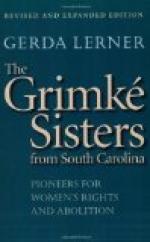This book was the most effective answer ever given to the appeal made against free discussion, based on the Southampton massacre. It was, in fact, an offset of the horrors of that bloody affair, giving, as it did, a picture of the deeper horrors of slavery. It was the first adequate disclosure of this “bloodiest picture in the book of time,” which had yet been made, and all who read it felt that, fearful as was the Virginia tragedy, the system which provoked it included many things far worse, and demanded investigation and discussion. Issued in pamphlet form, the “Testimony of a Thousand Witnesses,” was extensively circulated over the country, and most advantageously used by anti-slavery lecturers and advocates; and it is not too much to say that by awakening the humanity and pride of the people to end this national disgrace, it made much easier the formation of the anti-slavery political party.
In the preparation of this work, Mr. Weld received invaluable assistance from his wife and sister. Not only was the testimony of their personal observation and experience given over their own names, but many files of Southern papers were industriously examined for such facts as were needed, and which Mr. Weld arranged. Early in January, 1839, Sarah writes:—
“I do not think we ever labored more assiduously for the slave than we have done this fall and winter, and, although our work is of the kind that may be privately performed, yet we find the same holy peace in doing it which we found in the public advocacy of the cause.”
Referring a little later to this work, she says: “We have been almost too busy to look out on the beautiful winter landscape, and have been wrought up by our daily researches almost to a frenzy of justice, intolerance, and enthusiasm to crush the viper that is eating out the vitals of the nation. Oh, what a blessed privilege to be engaged in labor for the oppressed! We often think, if the slaves are never emancipated, we are richly rewarded by the hallowed influence of abolition principles on our own hearts.”
In a recent letter to me, Mr. Weld makes some interesting statements respecting this work. I will give them in his own words:—
“The fact is, those dear souls spent six months, averaging more than six hours a day, in searching through thousands upon thousands of Southern newspapers, marking and cutting out facts of slave-holding disclosures for the book. I engaged of the Superintendent of the New York Commercial Reading-Room all his papers published in our Southern States and Territories. These, after remaining upon the files one month, were taken off and sold. Thus was gathered the raw material for the manufacture of ‘Slavery As It Is.’ After the work was finished, we were curious to know how many newspapers had been examined. So we went up to our attic and took an inventory of bundles, as they were packed heap upon heap. When our count had reached twenty thousand newspapers, we said: ‘There, let that suffice.’ Though the book had in it many thousand facts thus authenticated by the slave-holders themselves, yet it contained but a tiny fraction of the nameless atrocities gathered from the papers examined.”




